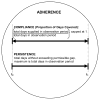Measuring and improving adherence to osteoporosis pharmacotherapy
- PMID: 20498602
- PMCID: PMC3160417
- DOI: 10.1097/BOR.0b013e32833ac7fe
Measuring and improving adherence to osteoporosis pharmacotherapy
Abstract
Purpose of review: Osteoporosis is a major public health issue resulting in considerable fracture-related morbidity. Although effective treatment exists, adherence to osteoporosis pharmacotherapy is suboptimal and linked to reduced drug effectiveness. In this paper, we review methods of measuring and improving adherence to osteoporosis pharmacotherapy.
Recent findings: Most patients will stop osteoporosis pharmacotherapy, yet the majority who discontinue will reinitiate treatment after an extended gap. The key to improving adherence to osteoporosis pharmacotherapy is to reduce the number and length of gaps in treatment. Multifaceted and individualized interventions may help to improve adherence. New strategies aimed at identifying patients likely to stop therapy may also facilitate the development of targeted interventions.
Summary: Adherence to osteoporosis pharmacotherapy is suboptimal with short periods of persistence and lengthy gaps in therapy. Regular communication regarding the importance of continued therapy is critical. More research to help identify risk profiles of patients likely to become nonadherent, targeted multifaceted interventions to maximize adherence to therapy, and data to support when patients may safely consider a physician directed drug holiday is needed.
Figures


Similar articles
-
Insufficient persistence of and adherence to osteoporosis pharmacotherapy in Japan.J Bone Miner Metab. 2021 May;39(3):501-509. doi: 10.1007/s00774-020-01188-w. Epub 2021 Jan 5. J Bone Miner Metab. 2021. PMID: 33403498
-
Persistence with bisphosphonate treatment for osteoporosis: finding the root of the problem.Am J Med. 2006 Apr;119(4 Suppl 1):S12-7. doi: 10.1016/j.amjmed.2005.12.018. Am J Med. 2006. PMID: 16563936 Review.
-
Role of the Pharmacist in Medication Therapy Management Services in Patients With Osteoporosis.Clin Ther. 2015 Jul 1;37(7):1573-86. doi: 10.1016/j.clinthera.2015.03.023. Epub 2015 Apr 23. Clin Ther. 2015. PMID: 25913920 Review.
-
Autonomy begets adherence: decisions to start and persist with osteoporosis treatment after group medical consultation.Arch Osteoporos. 2020 Sep 5;15(1):138. doi: 10.1007/s11657-020-00809-1. Arch Osteoporos. 2020. PMID: 32888079
-
Insufficient persistence to pharmacotherapy in Japanese patients with osteoporosis: an analysis of the National Database of Health Insurance Claims and Specific Health Checkups in Japan.Arch Osteoporos. 2021 Sep 13;16(1):131. doi: 10.1007/s11657-021-00993-8. Arch Osteoporos. 2021. PMID: 34515872
Cited by
-
Adherence to osteoporosis drugs and fracture prevention: no evidence of healthy adherer bias in a frail cohort of seniors.Osteoporos Int. 2011 Mar;22(3):943-54. doi: 10.1007/s00198-010-1309-z. Epub 2010 Jun 8. Osteoporos Int. 2011. PMID: 20532481 Free PMC article.
-
Bisphosphonate prescribing, persistence and cumulative exposure in Ontario, Canada.Osteoporos Int. 2012 Mar;23(3):1075-82. doi: 10.1007/s00198-011-1645-7. Epub 2011 May 21. Osteoporos Int. 2012. PMID: 21604008 Free PMC article.
-
Advancing the Science and Practice of Medication Adherence.J Gen Intern Med. 2018 Feb;33(2):216-222. doi: 10.1007/s11606-017-4198-4. J Gen Intern Med. 2018. PMID: 29204969 Free PMC article. Review.
-
Patient-reported reasons for nonadherence to recommended osteoporosis pharmacotherapy.J Am Pharm Assoc (2003). 2017 Jul-Aug;57(4):503-509. doi: 10.1016/j.japh.2017.05.003. Epub 2017 Jun 8. J Am Pharm Assoc (2003). 2017. PMID: 28602783 Free PMC article. Clinical Trial.
-
Anti-osteoporotic therapy in Denmark--predictors and demographics of poor refill compliance and poor persistence.Osteoporos Int. 2013 Jul;24(7):2079-97. doi: 10.1007/s00198-012-2221-5. Epub 2012 Nov 22. Osteoporos Int. 2013. PMID: 23179576
References
-
- U.S. Department of Health and Human Services. Bone health and osteoporosis: a report of the Surgeon General. Rockville, MD: U.S. Department of Health and Human Services, Office of the Surgeon General; 2004.
-
- Burge R, Dawson-Hughes B, Solomon DH, et al. Incidence and economic burden of osteoporosis-related fractures in the United States, 2005–2025. J Bone Miner Res. 2007;22:465–475. - PubMed
-
- MacLean C, Newberry S, Maglione M, et al. Systematic review: comparative effectiveness of treatments to prevent fractures in men and women with low bone density or osteoporosis. Ann Intern Med. 2008;148:197–213. - PubMed
-
- Siris ES, Selby PL, Saag KG, et al. Impact of osteoporosis treatment adherence on fracture rates in North America and Europe. Am J Med. 2009;122:S3–S13. - PubMed
Publication types
MeSH terms
Substances
Grants and funding
LinkOut - more resources
Full Text Sources
Medical
Research Materials
Miscellaneous

